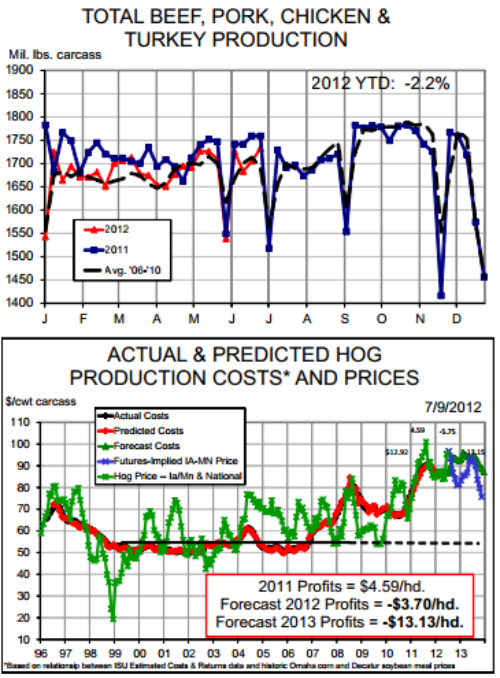



CME: CME Host WASDE Online Discussion
US - CME Group will host an interactive online discussion session at 2:30 p.m. tomorrow (Tuesday 10 July) regarding Wednesday’s USDA Crop Production and World Agricultural Supply and Demand (WASDE) reports.
The speakers for the event will be Dan Basse,
President of AgResource Company and Terry Roggensack, CoOwner of The Hightower Report. Click here to register for the
online discussion.
Steve Meyer writes: The result of some windshield crop
survey time over the past two weeks confirms the dire situation in
southern Indiana and Illinois. Corn in those areas looks very bad.
Some acres will not be salvaged. Others will see very low yields.
Central Iowa and Illinois from the Quad Cities to Champaign
LOOKED pretty good but was virtually all tasseled with much of it in
the pollination stage during last week’s extreme heat. The Springfield area was, generally, in the same boat two weeks ago. Everywhere I travelled was in dire need of rain. Grasses in pastures and
roadsides were brown everywhere. The soybeans still looked pretty good. I’m sure some plants were smaller than desired but there
was little “from the road” damage. Some timely rains would very
likely still result in decent yields from most acres but those showers
had better arrive soon. Today’s Crop Progress report will likely
show 40% or so of soybean acres blooming. Last week’s figure
was 26%, more than double the 5-year average of 12%. One thing
appears certain — The early-planted corn crop did not “miss the
heat” with early pollination.
Last week’s total meat and poultry output of 1.612
billion pounds was 2.3% lower than one year ago and brought
the year-to-date total, based on daily data, to 44.525 billion
pounds, 1.8% lower than in 2011. The chart at right shows weekly data for total meat and poultry output. Note that it doe s not include data for last week and that the year-on-year comparison for
these weekly data stands at –2.2%. It is clear to see that the yearon-year declines became much larger in June, driven primarily by
sharply lower poultry output and pork production much closer to
year-ago levels than was seen in April and May.
We still expect the year-on-year comparisons for chicken
to get more and more positive as this year’s weekly data are compared to the sharply lower level’s witnessed last year after the industry’s downsizing got rolling in earnest. Broiler egg sets for two
weeks ago (the most recent data available) of 196.2 million were
only 0.5% lower than in 2011. Chick placements that week numbered 165.7 million, just 1.8% lower than last year.
Our expectations for beef are just the opposite. Fed cattle
supplies will continue to run below year-ago levels and we think the
large positive impact of this year’s carcass weights will get smaller
primarily due to higher feed costs. One contributing factor is that
distillers grains with solubles (DGS) do not help costs as much as
they once did. The price of DDGS (the dried version of DGS) had
been, until just last week, above 90% of the price of corn on perpound basis since late March. It dropped to 87% last week but we
expect it to go higher as ethanol production drops in response to
lower corn prices. DDGS will still be a major component of cattle
diets since DDGS-corn price ratios at this level are even more disadvantageous to pork and poultry producers. But they will provide
little cost relief to cattle feeders, putting some pressure on weights
— at least on a year-on-year basis.
Hot weather has already begun to impact pork supplies
and high feed costs will play a role as well for the remainder of the
year. Last week’s producer-sold barrows and gilts reported to the
mandatory price reporting system averaged 201.9 pounds, 0.6
pounds or 0.3% lower than last year. That is the first time since
February — and only the second time this year — that weights
were lower than in 2011. Looking forward, average production
costs are now forecast to go above $94/cwt for hogs sold in September and to AVERAGE more than $93/cwt for all of 2013. Costs
that high will impact market weights for the foreseeable future.









